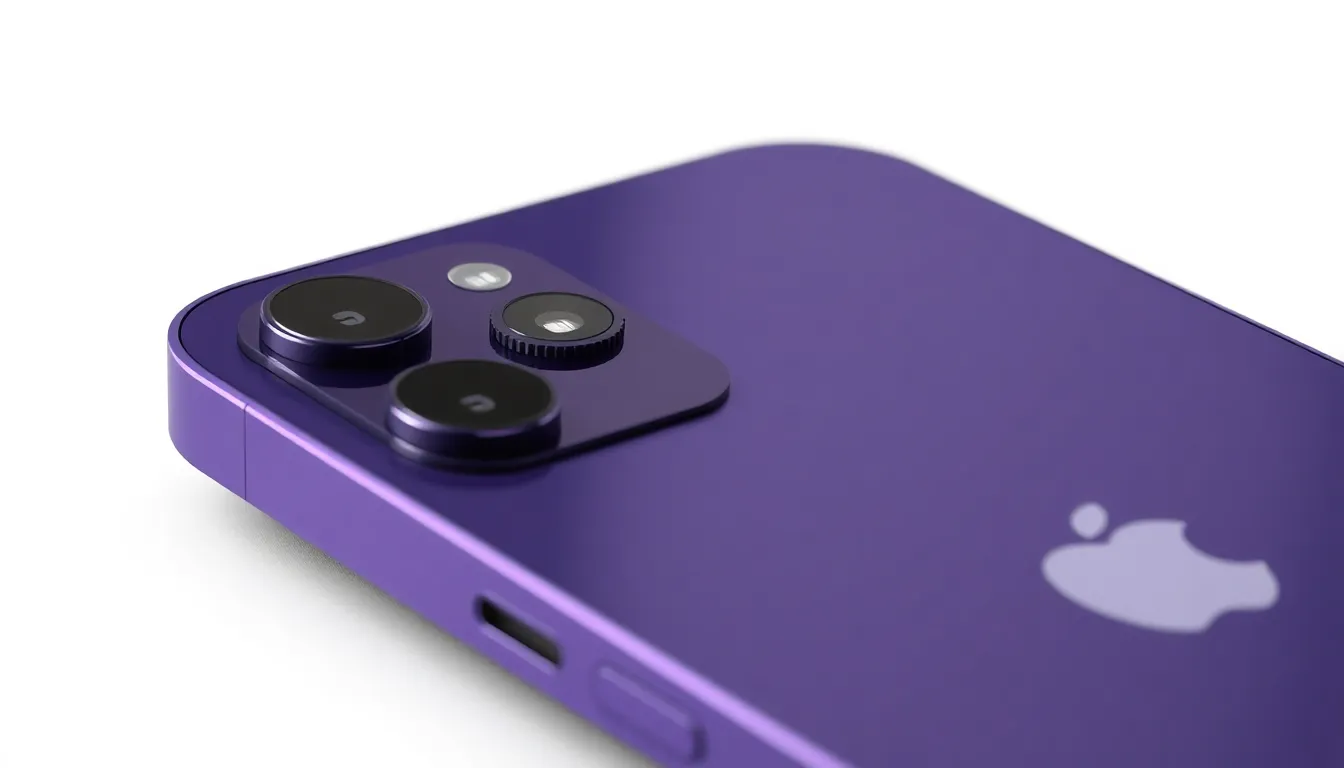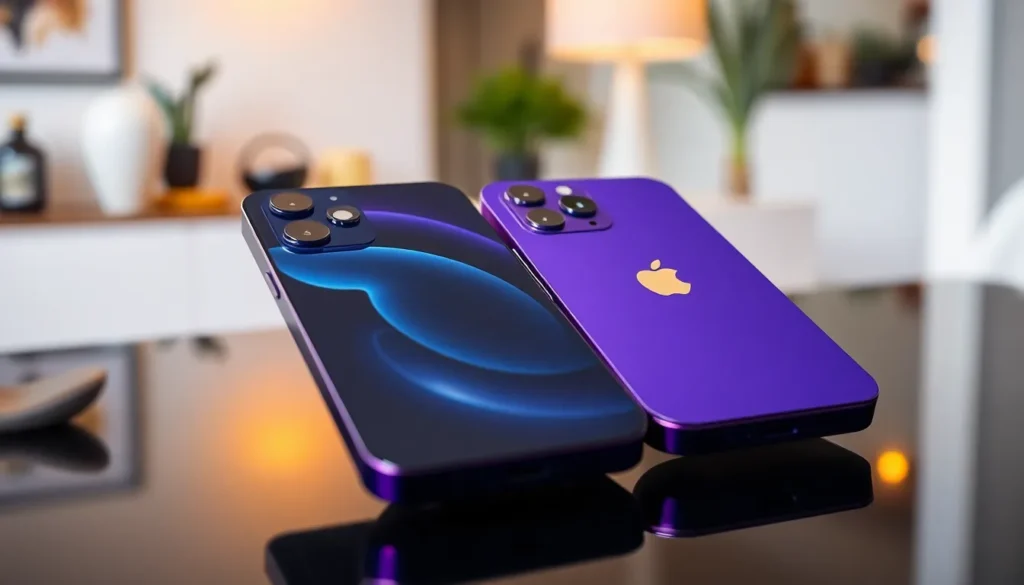Table of Contents
ToggleWhen it comes to smartphones, Apple has a knack for keeping fans on their toes. With the iPhone 14 now strutting its stuff alongside the trusty iPhone 13, the question on everyone’s lips is: what’s the real difference? Spoiler alert: it’s not just a shiny new color or a slightly faster processor.
Overview of iPhone 13 and 14
The iPhone 13 and iPhone 14 differ significantly in various aspects. Performance enhancements in the iPhone 14 include the A16 Bionic chip, which provides faster processing and improved graphics. Users can experience up to 20% better performance compared to the A15 Bionic chip found in the iPhone 13.
Camera advancements also set these models apart. While both phones feature dual-camera systems, the iPhone 14 introduces improved low-light capabilities and a new Photonic Engine for enhanced image processing. Users benefit from clearer photos and more vibrant colors with the latest model.
Display quality remains consistent with a 6.1-inch Super Retina XDR display on both devices. However, the iPhone 14 features enhanced brightness capabilities, offering up to 2,000 nits peak brightness outdoors. Such brightness improvement assists in visibility during sunny conditions.
Battery life represents another vital difference. The iPhone 14 boasts longer battery performance, allowing for extended usage between charges. Users can expect around 20 hours of video playback compared to approximately 19 hours for the iPhone 13.
Design aspects also vary slightly. The iPhone 14 offers new color options, alongside the familiar aluminum and glass body. A notable difference includes the presence of a slightly larger camera bump on the iPhone 14, accommodating the upgraded camera hardware.
Connectivity enhancements include support for satellite communication in the iPhone 14 for emergency situations. This feature allows users to send messages when out of cellular range. Additionally, both devices support 5G technology, ensuring fast internet speeds when connected to compatible networks.
These distinguishing features make the iPhone 14 a compelling upgrade over the iPhone 13 for those seeking the latest technology and performance enhancements.
Design Comparisons

Design elements mark a significant distinction between the iPhone 13 and iPhone 14. While both share a sleek aesthetic, several exterior changes enhance the iPhone 14’s look and feel.
Exterior Changes
The iPhone 14 features a slightly larger camera bump, accommodating advanced hardware for improved photography. With new internal layouts, engineers optimized space for better performance. Notably, the rear glass surface offers a more refined finish, providing enhanced durability. Additionally, the overall weight of the devices remains similar, ensuring users can enjoy the benefits without extra bulk. Enhancements contribute to a sophisticated appearance, aligning with modern consumer expectations.
Color Options
Color variety expands with the iPhone 14, introducing fresh shades. The new model includes Deep Purple, a striking option absent in the iPhone 13 lineup. Users can also choose classic colors like Starlight and Midnight, which maintain a timeless appeal. Each shade complements the device’s design, adding personality to the phone’s exterior. Both iPhone models, however, retain some color options, allowing those who prefer familiar aesthetics to stick with what they know. Options cater to diverse tastes, ensuring every user can find their perfect match.
Performance Differences
The iPhone 14 boasts remarkable performance improvements compared to the iPhone 13, largely driven by advancements in processing capabilities and battery life.
Processor Upgrades
Apple’s introduction of the A16 Bionic chip in the iPhone 14 signifies a considerable leap in processing power. Up to 20% better performance compared with the A15 Bionic chip in the iPhone 13 enhances multitasking and app performance. Increased efficiency also leads to smoother graphics rendering, benefiting gaming and resource-intensive tasks. This chip features a new 6-core CPU structure that optimizes power consumption while delivering superior speeds. Users experience faster app launches and improved responsiveness with the iPhone 14, setting a new benchmark in smartphone performance.
Battery Life Enhancements
Battery life improvements in the iPhone 14 contribute to a more enduring user experience. Offering around 20 hours of video playback, it slightly outlasts the iPhone 13’s 19 hours. Optimized internal components enhance energy efficiency, allowing users to enjoy extended usage without frequent recharges. The A16 chip also plays a role in prolonging battery life while supporting advanced features. Users benefit from longer hours of streaming, gaming, and browsing. Design enhancements further accommodate battery performance, making the iPhone 14 a reliable choice for users seeking longevity.
Camera Improvements
The iPhone 14 enhances photography with significant camera upgrades compared to the iPhone 13. Improvements cater to users who prioritize mobile photography, making it a compelling choice.
Camera Specs Comparison
The rear camera system on the iPhone 14 includes a 12MP main camera and a 12MP ultra-wide camera, similar to the iPhone 13. A larger sensor captures more light in low-light settings, resulting in better detail and clarity. Optical image stabilization improves stability during handheld shots. Furthermore, the front camera also features a 12MP sensor, ensuring consistent selfie quality across the models. Both models support 4K video recording at up to 60 fps, but the iPhone 14 adds Action mode, allowing smoother video capture during motion.
Night Mode and Features
Night mode on the iPhone 14 delivers improved low-light performance. Enhanced software algorithms optimize image quality, reducing noise and enhancing clarity in dark environments. Faster aperture settings allow more light, resulting in brighter images. The iPhone 14 introduces Photonic Engine technology, optimizing color and detail in low-light scenarios. These features elevate night photography experiences, ensuring vibrant results regardless of the lighting conditions. Users benefit from the distinct enhancements available in this latest iteration.
Software Features
The software experience marks a key difference between the iPhone 13 and iPhone 14.
iOS Versions
iPhone 13 launched with iOS 15 while iPhone 14 ships with iOS 16. Users of the iPhone 14 benefit from advanced features like enhanced notifications and improved privacy settings. An updated Focus mode allows for better customization, letting users filter notifications and apps based on their activities. Additionally, iOS 16 introduces Live Activities, providing real-time updates on sports events, deliveries, and more right on the lock screen. Compatibility with future iOS updates becomes a consideration, as newer models typically receive updates for a longer period.
Exclusive Features in iPhone 14
Several features exclusive to the iPhone 14 enhance its usability. Emergency SOS via satellite offers connectivity during emergencies when cellular services aren’t available. Crash Detection, also new to the iPhone 14, senses severe car crashes and automatically dials emergency services. Photonic Engine technology for photography introduces improved image quality in low-light scenarios, providing richer colors and better details. Enhanced FaceTime capabilities allow for improved video interactions with new spatial audio and Portrait mode options, elevating the overall experience.
Pricing and Availability
Pricing for the iPhone 13 and iPhone 14 differs based on storage options. The iPhone 13 starts at $699 for the base model, whereas the iPhone 14 begins at $799. This price increase reflects the enhanced features and technological advancements of the newer model.
Current availability remains favorable for both devices. Apple maintains stock for the iPhone 13, ensuring easy access for consumers. In contrast, the iPhone 14 experiences higher demand, leading to variable stock levels at retailers.
Purchasing options include direct orders from Apple’s official website, authorized retailers, and carriers. Customers can choose installment plans or trade-in programs, which help reduce initial costs. The iPhone 14 continues to be available for pre-order, and customers receive their devices shortly after launch.
Sales data indicates strong consumer interest in both models. The iPhone 14’s advanced features contribute to its appeal, with many users eager to upgrade. Competitive incentives from carriers and retailers also enhance the purchasing experience.
In terms of launch dates, the iPhone 14 debuted in September 2022, while the iPhone 13 was released in September 2021. This timeline influences consumer decisions, as newer models typically attract more attention.
Overall, pricing strategies and availability remain crucial factors for potential buyers. As Apple releases new models, a shift in focus towards the latest technology influences purchasing patterns. Users considering an upgrade should evaluate their budget, needs, and the features that matter most to them.
The differences between the iPhone 13 and iPhone 14 are clear and impactful. With significant upgrades in performance camera capabilities and battery life the iPhone 14 stands out as a compelling choice for users seeking the latest technology. Enhanced features like the A16 Bionic chip and advanced photography options cater to both casual users and enthusiasts alike.
While the iPhone 13 remains a solid device the iPhone 14’s improvements in durability design and software experience make it a worthwhile investment for those ready to embrace the newest innovations. As users weigh their options price availability and personal preferences will play crucial roles in their decision-making process.




